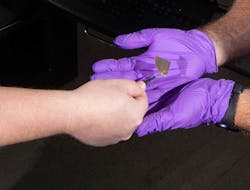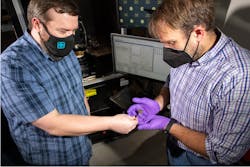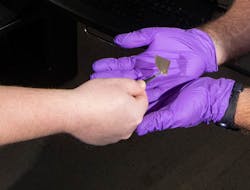Record-Breaking, Ultrafast Diodes Could Protect the Grid from EMPs
Engineers at Sandia National Laboratories have developed a small electronic device that can siphon off excess electricity and send it to ground in just a few billionths of a second while operating at a record-breaking 6,400 V. This should be a significant step towards protecting the nation’s electric grid from electromagnetic pulses. The team’s ultimate goal is to provide protection from voltage surges, which could lead to months-long power interruptions, with an upgraded version of the device that operates at up to 20,000 volts.
Electromagnetic pulses (or EMPs) can be caused by natural phenomena, such as solar flares, or human activity, such as a nuclear detonation in the atmosphere. An EMP generates huge voltages in a few billionths of a second, potentially damaging electronic devices over large swaths of the country.
Although EMPs are unlikely, according to Bob Kaplar, manager of a semiconductor device research group at Sandia, if there were one that damaged the huge transformers that form the backbone of the U.S. electric grid, it could take months to replace them and re-establish power to affected regions.
The new device is a diode, much like the diodes found in nearly every electronic device. They act as one-way valves, letting electricity flow in one direction, but not the other. They are commonly used to convert AC power into DC power.
“There’s a limit to how much current can flow through our diode,” says Kaplar. “It cannot block an infinite voltage. However, our device uses the point at which the diode can no longer block the high voltage, holds the voltage to that level, and shunts excess current through itself to the ground and away from the grid equipment in a controlled, non-destructive fashion.”
The voltage surges caused by EMPs are a hundred times faster than those caused by lightning, so experts don’t know if devices designed to protect the grid against lightning strikes would work against an EMP, says Jack Flicker, a Sandia electric grid resiliency expert on the team.
“The electric grid has a number of different protections,” Flicker explains. “They range in timeframe from very fast to very slow, and they’re overlaid on the electric grid to ensure an event cannot cause a catastrophic outage of the electric grid. The fastest protection typically found on the grid reacts against pulses at one millionth of a second to protect against lightning. For EMPs, we’re talking 10 billionths of a second, a hundred times faster.”
The new Sandia device can react that quickly.
The diode is made from gallium nitride, the same material used in LEDs, Kaplar said. Gallium nitride is a semiconductor, like silicon. But because of its chemical properties, it can hold off much higher voltages than silicon before it breaks down than silicon. The material also responds quickly, which makes it a good candidate for delivering the fast response needed to protect the grid from EMPs.
The Sandia team made the devices by growing gallium nitride semiconductor layers using chemical vapor deposition. In the process, they heat a commercially available gallium nitride wafer to around 1,800°F and then add vapors that include gallium and nitrogen atoms. These chemicals form layers of crystalline gallium nitride on the wafer.
By tweaking the ingredients and the “baking” process, the team can build layers with different electrical properties. By creating the layers in a specific order, combined with processing steps such as etching and adding electrical contacts, the team produced devices with the performance they needed.
“A major challenge of constructing these very high voltage diodes is the need to have very thick gallium nitride layers,” says Mary Crawford, a Sandia scientist leading diode design and fabrication for the project. “The drift regions of these devices have thicknesses of about 50 μm, or 1/6th of a sheet of notebook paper. This may not sound like a lot, but the growth process we use can have growth rates of only 1 or 2 μm per hour. A second major challenge is maintaining very low densities of crystalline defects, specifically impurities or missing atoms in the semiconductor material, throughout the growth time to get devices that work at very high voltages.”
For the team to build diodes that operate at 20,000 volts, it will need to grow the thick layer even thicker with even fewer defects.
To test the diode, the engineers used specialized equipment capable of applying a high voltage pulse and measuring the electric pulse reflected back from the diode to accurately determine when the device turns on in less than a billionth of a second.
Beyond protecting the grid from EMPs, the diodes could also protect the electronics that convert electricity from roof-top solar panels into power that can be used by household appliances, and even electric car charging equipment.


